Project Descriptions
142 through 158
2005 - 2006 |
| 2005 and 2006 were busy and seminal years We expended not only our design envelope - we stretched our capacity to build. In the 53 years of projects listed here, this two years of work represents nine percent of the total production executed in less than four percent of the time. In this period, the work included a 15 acre urban master plan, our most advanced NavCenter built to date, one of a number of Centers i which the Armature concept became main stream, significant development of our RDS concept, and a continued return to residential projects. These various projects feed each other and new directions emerged out of this interaction. What has been an ad-hoc, on-and-off practice over many decades which finally became Taylor Architecture has always been original - what is evolving, organically out of the work itself, is an unique voice and gesture which is more than mere originality. It will take the completion of these works and a few more years of this volume of work for this new gestalt to reach a rich maturity. I have never tried to make a “style” and although I have always had a bias towards the Organic School of design by preference, familiarity and the influence of where I live, I have designed each project from a blank slate and collaborated with my associates not trying to bend their p]special talents to a certain dogma. What can be seen now is that we are all beginning to teach, influence and guide each other and evolve a deep and true collaboration - a rare thing in architecture. This is an outcome brought about by deliberate design. “Taylor” Architecture does not refer to Matt Taylor and only my design work. It refers to a practice model [future link] based on the Taylor Method - a work process independent of yet applicable to any field of work. We are in the early stages of this practice and it is still fragile. It can be derailed yet I think only if we let it. The economics of architectural practice are a challenge in any circumstance and always have been so. For a new (and ancient) practice model embracing such a wide range of projects - many of which themselves are out of the economic main stream - this is a double challenge. It requires a high level of productivity just to stay afloat given the scope of the work and the innovation level involved. We are meeting this by synthesizing 50 years of experience in the many facets of architecture, component manufacturing and construction processes while integrating (not adding) the new computer tools to invent a higher level of design-build-use system. |
|
clinton_memorial_hospital |
Work 142
2005
- Executive Offices
Clinton Memorial Hospital
|
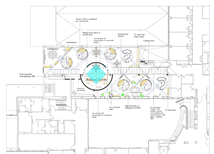 |
Plan View of offices.
[future link] |
|
Client:
Work:
Design:
DBU Team:
Location:
Status:
Notes:
|
CMH Regional Health System
Design, manufacture, install turn-key environment
Matt Taylor, Bill Blackburn
Bill Blackburn, AI Shop
Wilmington, Ohio, USA
Not Built
A difficult narrow room with a roof top view on one side and an Atrium view on the other. It was a POD-based design. The budget, cost value, equation never came together. A case where the increase of productivity and collaborative synergies of the executive team could not be accounted as having economical value sufficient to justify the costs. a typical situation given today’s dominate paradigm of work and means of accounting value. The office set up is not considered to have a significant impact on productivity. Executive teams, because they work hard, are assumed to be at peak performance. Collaboration is not distinguished from cooperation. Building an environment and incorporating a new work process for the executive team remains a challenge. I liked the CEO and his team and thought this time the case could be made but the old models won out again. |
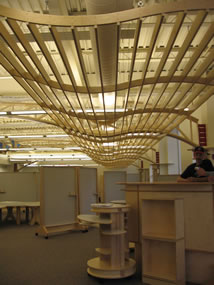 |
Photo taken durning install process.
[future link] |
|
Client:
Work:
Design:
DBU Team:
Location:
Status:
Notes: |
USA Department of Veterans Affairs
Design, manufacture, install turn-key environment
Bill Blackburn
Bill Blackburn, AI Shop
Cleveland, Ohio
Completed
W. |
Work 144
2005
- Alse Group
Executive Offices and Collaborative Spaces
|
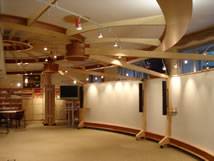 |
Picture of the main collaborative space taken shorly after the installation of lighting.
click on picture for
more information
|
|
Client:
Work:
Design:
DBU Team:
Location:
Status:
Notes:
|
Ales Groupe
Design, manufacture, install turn-key environment
Bill Blackburn
Bill Blackburn, AI Shop, Matt Taylor, Irina Sokolova, Maurizio Travaglini
Milan, Italy
Completed
W. |
Work 145
2005
- RDS Tree System |
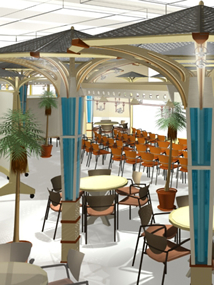 |
Drawing of rolling, adjustable “tree” Armature system.
click on 3d model graphic
for details |
|
Client:
Work:
Design:
DBU Team:
Location:
Status:
Notes: |
World Economic Forum
Design, Manufacture
Matt Taylor, Bill Blackburn
Bill Blackburn, Irina Sokolova, Matt Taylor
Davos Switzerland
Dormant
We have long wanted to design and build a light weight moving Armature system. The WEF will require this as their deployments become larger and more sophisticated. A key aspect of this project was to create a visual brand for the WorkSpace so that it is distinct from other Taylor Licensed environments. To date (mid-2007), this project has succumbed to time and budget constraints yet it is definitely still alive. It may take a year or two more before the scale and scope of the WorkSpace RDS demands it. A simpler aluminum and cloth tree unit was developed for 06 and 07 use and to prototype the idea. See #149. MG Taylor will, resources allowing, create a version of this for its own RDS. |
Work 146
2005
- SDC Master Campus Plan |
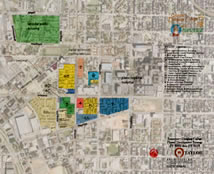 |
First sheet of set showing campus expansion phases
[future link] |
|
Client:
Work:
Design:
DBU Team:
Location:
Status:
Notes: |
SDC
15 Year Campus Master Plan
Jerry headley
Matt Taylor, Jerry headly
East Baltimore, Maryland
Completed - in revision; Work in progress
W. |
nashville_snowflake_compound |
Work 147
2005
- Nashville Snowflake Compound |
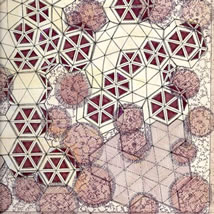 |
Top view showing typical Snowflake configuration
[future link] |
|
Client:
Work:
Design:
DBU Team:
Location:
Status:
Notes: |
MG Taylor
Design, Manufacture, Build, Operate
Matt Taylor
n/a
Nashville, Tennessee
Dormant
W. |
phoenix_house_post_usionian |
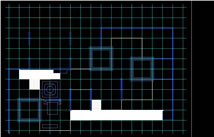 |
Plan view of modulare untits
[future link] |
|
Client:
Work:
Design:
DBU Team:
Location:
Status:
Notes: |
Study - Post Usonian Project
Design, Prototype
Matt Taylor
n/a
Not determined
Design Development
This is an adoption and update of my 1960s Unit House concept - see Work #28. This “zoned” house is designed to offer the greatest amount of flexibility and space-per-function while requiring the minimum footprint for a family four. |
Work 149
2006
- 06 Davos RDS Trees |
 |
Picture of Trees as used in 2006 and 2007 at the Annual Meeting and several regional deployments
[future link] |
|
Client:
Work:
Design:
DBU Team:
Location:
Status:
Notes:
|
World Economic Forum
Design, Manufacture
Matt Taylor Concept - MGT, AI, WEF, AIE team collaboration
Matt Taylor, Bill Blackburn, Butch Rice, Brian Ross, Rodney Meadows
Collaboration in MGT Nashville NavCenter - RDS deployment
Phase I completed (as shown); Phase II to be performed by AE
After it was determined that the 05 Armature System was too large and complex for WEF storage and deployments, a new adjustable Armature design was created - see Work #145. |
Work 150
2004
- KRP NavCenter |
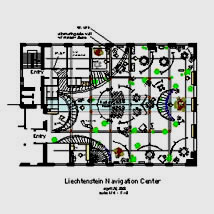 |
Plan view of layout
[future link] |
|
Client:
Work:
Design:
DBU Team:
Location:
Status:
Notes: |
Kaiser Ritter Partners
Design, Manufacture, Install
Bill Blackburn
Bill Blackburn, Matt Taylor, AI Shop, AI Europe
Liechtenstein
Phase One (RDS level) Installed
W. |
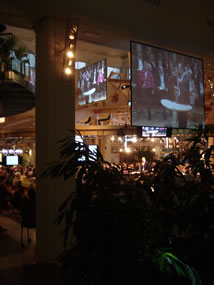 |
Picture of environment on opening day, January, 2007
click on picture for web site tour |
|
Client:
Work:
Design:
DBU Team:
Location:
Status:
Notes: |
UniCredit Bank
Design, Manufacture, Install
Matt Taylor and Bill Blackburn
Bill Blackburn, Paola Serra, Jerry Headly, Dick Lowndes, AI Shop, Massimo Maffei, Permastelisa Interiors, Forcellini Alessandro, others [future link: unicredit credits].
Turin, Italy
Built - NaVCenter process transfer program is nacent and scheduled to start the fall of 2007
The WEF RDS Armature [future link] - greatly augmented - finds a permanent home here to create a world class NavCenter. For the story of designing the NavCenter see: [future link]; For the story of building the NavCenter [future link]; For the story of bringing the NavCenter into a full practice [future link]. This NavCenter is built in an historic building as part of the UniManagement training facility for the senior 500 executives of UniManagement Bank. For my design criteria see: [future link]. This environment features a sophisticated multimedia capability, the first two POD maximus built and an extensive inside landscape for private time. |
leopard_guest_house_studio |
Work 152
2006
- Leopard Guest House and Studio Addition |
Client:
Work:
Design:
DBU Team:
Architect of Record:
Location:
Status:
Notes: |
Stan Leopard
Design, Manufacture, Project Management
Matt Taylor
Matt Taylor, Matthias Oppliger, Fred Stitt
Fred Stitt
Sebastopol, California
Not Built - redesigned for new program see Works #158, #159, #163, #164
W. |
Client:
Work:
Design:
DBU Team:
Location:
Status:
Notes: |
U.S. Department of Veterans Affairs
D
C
M
C
P
W. |
Work 154
2006
- VA Cincinnati NavCenter |
Client:
Work:
Design:
DBU Team:
Location:
Status:
Notes: |
U.S. Department of Veterans Affairs
Design, Manufacture, Install
Bill Blackburn
Bill Blackburn
Cincinnati
Design Development
W. |
elsewhere_guest_house_studio |
Work 155
2006
- Matt and Gailo Taylor Guest House and Studio |
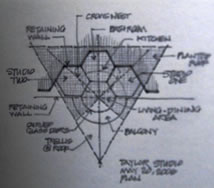 |
Sketch of Floor Plan
[future link] |
|
Client:
Work:
Design:
DBU Team:
Location:
Status:
Notes: |
Matt and Gail Taylor @ Elsewhere
Design, Manufacture, Build
Matt Taylor
n/a
Gualala, California
Design Development
This project is un funded due to several years of virtually no salary. Yet, the space becomes ever more needed. There is no place to work when I am home and no accommodations for professional and business guests, let alone family. Meanwhile the search goes on for a design solution for this beautiful and difficult to build on piece of ground. We did remove two trees last year creating the space to build and some structural wood - air curing now - to build with. There will be PostUsonian elements in this project as well as a bay Area Style sensibility (given where it is built). This design has a kinship with the house I showed Eichler in 1958 - see Work #6. Works #111 and #141 are earlier designs for the space. Any final design has to integrate with Gail’s Nest - Work #116. See also the Tree House design, Work #166, which may be built first as it is a much less expensive project. - it is a useful and fun design but not a substitute for a full Guest House - Studio. |
Work 156
2006
- Sojourner Douglass College Hotel, Shops, Offices, Training Facilities and Garage |
2001
(drawing
in progress)
|
|
|
Client:
Work:
Design:
DBU Team:
Location:
Status:
Notes: |
M
D
C
M
C
P
W. |
Work 157
2006
- VA Columbus Learning Exchange |
Client:
Work:
Design:
DBU Team:
Location:
Status:
Notes: |
Department of Veteran Affairs, U.S.A.
Learning Exchane for Columbus, Ohio
Bill Blackburn
Bill Blackburn, Jerry Headly, Rodney
C
P
W. |
leopard_dining_conference_rm |
Work 158
2006
- Leopard Dining/Conference Room |
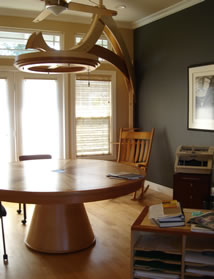 |
Photo taken during install process.
click on photo to go to web page |
|
Client:
Work:
Design:
DBU Team:
Location:
Status:
Notes: |
Stan Leopard
Dining/Conference Room
Matt Taylor, Bill Blackburn
Bill Blackburn, Rodney
Sebastopol, California
Installed - fixes required - in temporary use
W. |
| The focus of Taylor Architecture is not “just” to create works of fine architecture as this is conventionally thought of. There are many architects who are doing this to an extraordinary high standard. We do like to create works of architectural art and work diligently at doing so. Our work is to advance and demonstrate a new definition of architecture, itss function and the scope of its practice - and the method of this practice - that is made necessary by this time and place in human history. |
| This attitude and intent can be found back in the earliest Works profiled in this list of projects. It can also be seen that the what this means has undergone steady change and evolution for over 50 years. I started off wanting to become a “great” architect in the tradition of Richardson, Sullivan, Frank and Lloyd Wright, Greene and Greene, Maybeck, Goff, Schinler and the others who carried this tradition on. This was my starting point. As time progressed, the method of creating architecture became as important to me as the product itself. What was a proper human habitat and how it facilitated work, recreation, learning and living underwent a profound shift in my mind. The ecology-economics - as one issue - from a simple affordable house to planetary scale infrastructure became of one cloth. I saw that all of these were not separate issues or types of architecture and practice - they are all one thing and have to be addressed as such if true advancement is to be accomplished. These conclusions, as they came year after year, drove me back to the beginning over and over and caused me to search out ever new fields of study and work. It seemed I was always starting over. In a way I was and in a way I was not because it always came back to the beginning. |
| To date, a critical look at my work will reveal four things. First, as work is generally judged these are not significant projects nor are there many that have been executed - as a body of work, however, there emerges value not found in the individual pieces. Second, the designs themselves, many radical for their time, are no longer - looked at superficially - outside the mainstream of the work being built today - when experienced and used, lived and worked in, another unexpected dimension reveals itself and this is the basis for the strong growing popularity for these environments. This work is not photo opportunity architecture. Third, The how of the making of these Works and the why and how of their use, is an integral aspect of their design and art. It is the Design/Build/use totality which is the basis of a new practice model - a collaborative practice model which includes all the team members creativity as well as the client’s. Fourth, the ambition of this practice is far beyond the range and scope of the past and even what may be reasonably considered possible in the foreseeable future. In detail, it is almost completely opposed to present trends. Yet, the number of opportunities keep growing and, as can be expected, most often not from conventional sources. This has been a practice on the periphery of the mainstream of architecture. The goal has been to make it mainstream yet to do this without either fighting or conforming to the status quo. |
| To bet that this practice model will succeed would not be judged as an intelligent risk by most. I do not know, myself, it there is any chance at all that what we are about will prevail. Success is not the determining factor in my choosing of what to do. This possibility of “failure” once bothered me; no longer. It is the WORK which is important. I will do my best for it. The rest is out of my hands - as it should be. This effort may succeed; it may fail; it may become fruitful long in the future. The free market of ideas and commerce - if we manage to hold on to them - will determine the outcome. |
|
Matt
Taylor
Elsewhere
June 11, 2007

SolutionBox
voice of this document:
VISION • STRATEGY • EVALUATION
|
|
|
posted:
June 11, 2007
revised: June 14, 2007
• 20070611.346209.mt • 20070614.229091.mt •
(note:
this document is about 70% finished)
Matt
Taylor 615 525 7053
me@matttaylor.com
Copyright© Matt
Taylor 2005, 2006, 2007
|
|
|